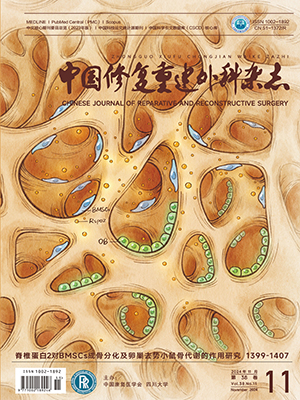Objective To fabricate a nanohydroxyapatite-chitosan(nano-HA-CS) scaffold with high porosity by a simple and effective technique and to evaluate the physical and chemical properties and the cytocompatibility of the composite scaffold. Methods The threedimensional nano-HA-CS scaffolds with high porosity were prepared by the in situ hybridization-freeze-drying method. The microscopic morphology and components of the composite scaffolds were analyzed by the scanning electron microscopy (SEM), the transmission electron microscopy(TEM), the X-ray diffraction(XRD)examination, and the Fourier transformed infrared spectroscopy(FTIR). The calvarial osteoblasts were isolated from the neonatal Wistar rats. The serial subcultured cells (3rd passage) were respectively seeded onto the nanoHACS scaffold and the CS scaffold, and then were cocultured for 2, 4, 6 and 8 hours. At each time point,four specimens from each matrix were taken to determine the celladhesion rate. The cell morphology was observed by the histological staining and SEM. Results The macroporous nanoHACS scaffolds had a feature of high porosity with a pore diameter from 100 to 500 μm (mostly 400500 μm). The scaffolds had a high interval porosity; however, the interval porosity was obviously decreased and the scaffold density was increased with an increase in the contents of CS and HA. The SEM and TEM results showed that the nanosized HA was synthesized and was distributed on the pore walls homogeneously and continuously. The XRD and FTIR results showed that the HA crystals were carbonatesubstituded and not wellcrystallized. The cytocompatibility test showed that the seeded osteoblasts could adhere the scaffolds, proliferating and producing the extracellular matrix on the scaffolds. The adherence rate for the nanoHACS scaffolds was obviously higher than that for the pure CS scaffolds. Conclusion The nano-HA-CS scaffolds fabricated by the in situ hybridization-freeze-drying method have a good physical and chemical properties and a good cytocompatibility; therefore, this kind of scaffolds may be successfully used in the bone tissue engineering.
Citation: WANG Xin,LIU Lingrong,ZHANG Qiqing.. A STUDY ON NANOHYDROXYAPATITECHITOSAN SCAFFOLD FOR BONE TISSUE ENGINEERING. Chinese Journal of Reparative and Reconstructive Surgery, 2007, 21(2): 120-124. doi: Copy




